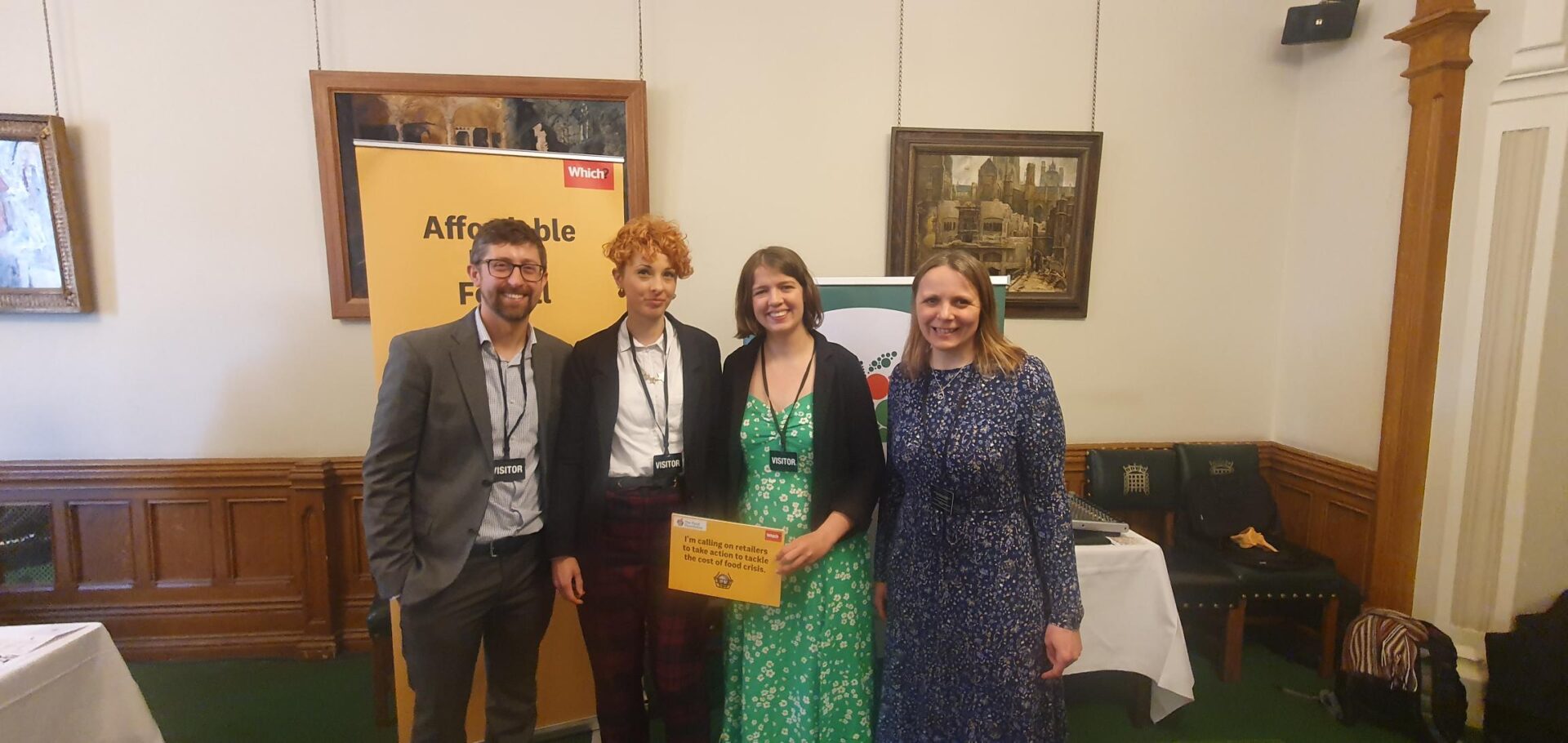The CDRC Priority Places for Food team were invited to the House of Commons earlier this week in order to share their work on food insecurity.
The event, ‘Tackling the Cost of Food Crisis’, was set up to share new research, led by Which?, on the availability of budget range options in small and large supermarket stores, and to launch a new film by The Food Foundation highlighting the lived experiences of those living in the areas of highest food insecurity.
CDRC’s Priority Places for Food Index (developed last year in collaboration with Which?) emphasises that food (in)security is determined both by access to food and the obstacles blocking access to that food. As a result, this event brought together policymakers, MPs, charity organisations and those with lived experiences of food insecurity and diet-related ill health, with the joint objectives of working together to improve access to affordable food and to remove the social barriers currently limiting access to that food.
The Priority Places for Food Index demonstrates that access to supermarkets plays an important part in the UK’s food security. Good access to supermarkets includes both online access (including availability of online delivery as well as the likelihood of individuals in a particular location to shop online) as well as in-person access (including proximity, travel time, and travel options to supermarkets).
Which? calls on supermarkets to do more
Which? took this research further, by exploring what choices consumers have if they have limited access to larger supermarkets and need to shop in smaller stores. Their research involved sending a team of mystery shoppers into 123 different-sized branches of Asda, Morrisons, Sainsbury’s and Tesco across the UK to assess the availability of a range of essential budget groceries.
Each shopper was armed with a list of around 29 different basic budget groceries to find in each store, and the results show that those core budget items were almost all available in larger stores, and almost all unavailable in smaller stores.
The shopping list used by Which? was developed in collaboration with CDRC researchers, and the outcomes of Which?’s research emphasised that having access to supermarkets was not always a guarantee that consumers could access affordable food. In fact, the items available in different-sized stores are not configured to cater to the areas in which those stores are located, but in fact based on store size (with a larger range of budget items available in larger stores, not areas of greater need).
Which? have called on retailers to do more to tackle food insecurity by ensuring budget ranges are available in smaller stores, using the Priority Places for Food Index as an example of how to determine which areas in the UK need access to affordable food most urgently. You can sign their #AffordableFoodForAll campaign here.
The Food Foundation – Sharing lived experiences
The powerful and emotional film launched by The Food Foundation focused on the lived experience of Melissa, who lives in Solihull, and who describes how difficult it is to feed her children during the cost of living crisis.
The Food Foundation used the Priority Places for Food Index to determine an area of particularly high food insecurity – Birmingham – and in the video, uses the expertise of GP Dr Ewan Hamnett to highlight the long-lasting health implications of food insecurity for individuals and, more long-term, the additional stress health inequalities are likely to place on the health and social care systems in future.
Alongside the launch of this video, the Food Foundation have made demands on both retailers and Government to ensure everyone can survive the cost of living crisis and eat well.
In particular, The Food Foundation called for the expansion and strengthening of the healthy start voucher and free school meal schemes.
The Priority Places for Food Index includes the eligibility and uptake data for these schemes. You can read more about the work CDRC has done previously on free school meals here, and read also how Dr Michelle Morris’s work with retailers has evidenced the value in expanding the healthy start voucher scheme.
What happens next?
The event was a reminder to all attendees that the cost-of-living crisis and its impacts are not going away any time soon, and that in order to effect change we need to get a clear picture of the extent of the problem.
The combined effect of the Priority Places for Food Index, Which?’s secret shopper research, and the accounts of lived experiences provided via The Food Foundation provide the evidence necessary to prompt action, with many attendees at the event signing the declaration on affordable food put forward jointly by Which? and The Food Foundation.
Furthermore, guests at the event were able to spend time using the Priority Places for Food Index, exploring how they as individuals or organisations can use it to develop targeted interventions to improve food security.
Which? also used Priority Places data to provide constituency-level evidence packs for the MPs in attendance, placing the evidence of the levels of food insecurity and contributing factors to that insecurity into the hands of decisionmakers.
Journalist and Radio 4 presenter Sheila Dillon, who chaired the event, said that it was hard not to be moved by the video created by The Food Foundation, and on Twitter noted that coming together for the event – with representation from both the Conservative and Labour parties – gave her hope that ‘democracy might be working’.
Dr Emily Ennis, Research and Impact Manager, Consumer Data Research Centre (Leeds)


